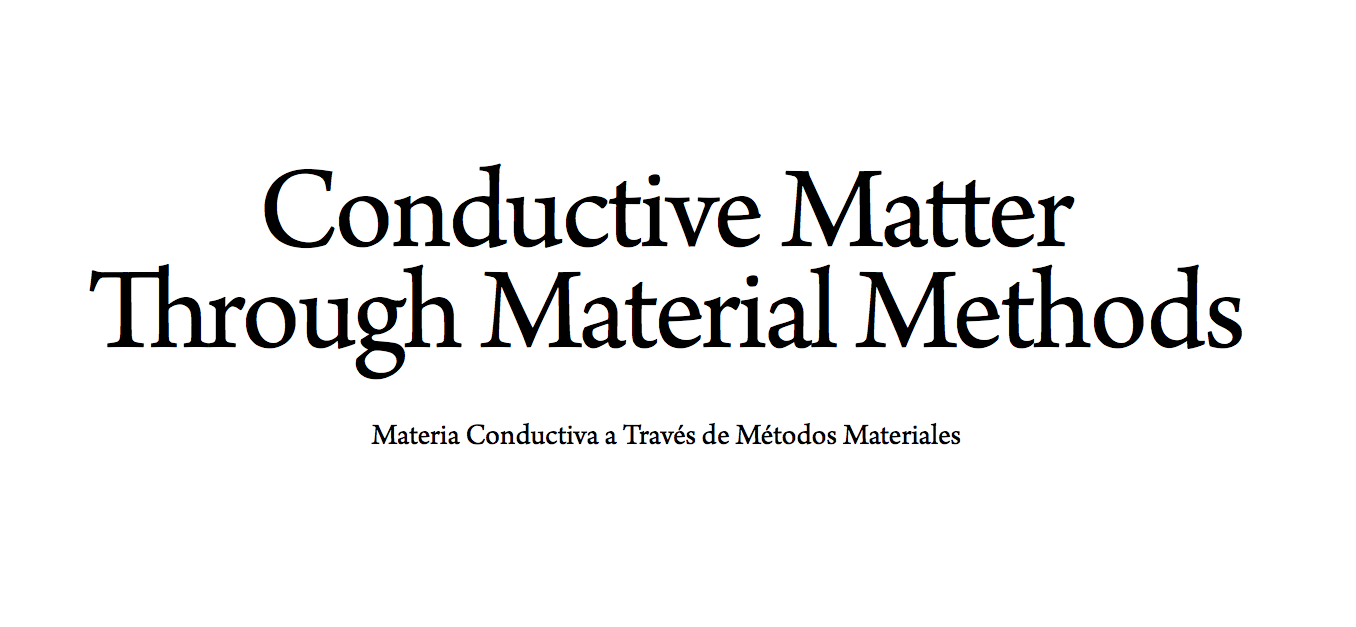Matèria conductiva a través de mètodes materials
DOI:
https://doi.org/10.46516/inmaterial.v10.238Paraules clau:
art conductiu, interacció tàctil, encarnación, neurofilosofia, recerca basada en la pràcticaResum
Aquest article presenta Inert Matter (2022), una exposició d'art experimental que investiga les dimensions tàctils i afectives de la tecnologia. El projecte se centra en la reactivació de pantalles tàctils descartades per transformar residus electrònics en obres d'art interactives, utilitzant fils conductors, díodes i la participació corporal del públic. Mitjançant una metodologia de recerca basada en la pràctica, l'obra desafia l'obsolescència assumida de les superfícies digitals trencades i les reubica com a espais de compromís sensorial i d’intimitat especulativa.
Basant-se en la filosofia del nou materialisme i la teoria de la interacció, el projecte replanteja el tacte com una trobada material i un gest polític, que resisteix l’aplanament habitual de l’experiència sensorial en la cultura digital. En destacar la vitalitat elèctrica de la matèria humana i no humana, Inert Matter proposa formes alternatives de sentir, interactuar i repensar la intimitat tecnològica en l’era del que és descartable.
Descàrregues
Referències
Barad, K. (2003). Posthumanist performativity: Toward an understanding of how matter comes to matter. Signs: Journal of Women in Culture and Society, 28(3), 801–831. https://doi.org/10.1086/345321
Barad, K. (2022). Re-membering time for the time being.
Barad, K. M. (2007). Meeting the universe halfway: Quantum physics and the entanglement of matter and meaning. Duke University Press.
Barrett, E. (2019). Materiality, affect, and the aesthetic image. In Carnal knowledge (Chap. 4). https://doi.org/10.5040/9780755603435.ch-004
Barrett, E., & Bolt, B. (Eds.). (2013). Carnal knowledge: Towards a ‘new materialism’ through the arts (1st ed.). I.B. Tauris. https://doi.org/10.5040/9780755603435
Barrett, E., Chare, N., De Bruyn, D., Hongisto, I., Keane, J., Kontturi, K., Kurikka, K., Martin, B., McCosh, L., Negrin, L., Parikka, J., Tiainen, M., Vasseleu, C., Watkins, L., & Woodcock, R. (2013). Carnal knowledge: Towards a ‘new materialism’ through the arts. Bloomsbury.
Braidotti, R. (2006). Affirming the affirmative: On nomadic affectivity.
Braidotti, R. (1994). Nomadic subjects: Embodiment and sexual difference in contemporary feminist theory. Columbia University Press.
Choudhury, S., Nagel, S. K., & Slaby, J. (2009). Critical neuroscience: Linking neuroscience and society through critical practice. BioSocieties, 4(1), 61–77. https://doi.org/10.1017/S1745855209006437
Classen, C. (2012). Sensations of a new age. In The deepest sense: A cultural history of touch (p. 167). University of Illinois Press. https://doi.org/10.5406/illinois/9780252034930.003.0008
Damasio, A. (2020, November 10). DISCUSSION #2: Functional and structural neuroimaging – Human Brainhttps://www.youtube.com/watch?v=vbKePH8Gu64 [Video]. YouTube. https://www.youtube.com/watch?v=vbKePH8Gu64
Damasio, A. R., San, N. Y., & Londoll, D. (2014). Does your “feeling of what happens” definition of consciousness extend to dreaming? If so, how do you conceptualise internally generated FWHs? In Dream consciousness (Chap. 10). Springer.
https://doi.org/10.1007/978-3-319-07296-8_10
Dormor, C. (2020). Textile as shimmering surface. In A philosophy of textile. Bloomsbury Visual Arts. https://doi.org/10.5040/9781474263238.0007
Dunne, A. (2005). Hertzian tales: Electronic products, aesthetic experience, and critical design (2005th ed.). MIT Press.
Felipe Cortés Salinas. (2023). Artistic research: Between transformative material and cognitive dynamics. JAR: Journal for Artistic Researchhttps://doi.org/10.22501/jarnet.0065. https://doi.org/10.22501/jarnet.0065
Finlay, L. (2002). Negotiating the swamp: The opportunity and challenge of reflexivity in research practice. Qualitative Research, 2(2), 209–230. https://doi.org/10.1177/146879410200200205
Flaxman, G. (Ed.). (2000). The brain is the screen: Deleuze and the philosophy of cinema. University of Minnesota Press.
Heinzel, T., & Hinestroza, J. P. (2020). Revolutionary textiles: A philosophical inquiry on electronic and reactive textiles.https://doi.org/ Design Issues, 36(4). https://doi.org/10.1162/desi_a_00574
Herrnstein, R. J. (1982). Stimuli and the texture of experience. Neuroscience & Biobehavioral Reviews, 6(1), 105–117. https://doi.org/10.1016/0149-7634(82)90012-4
Huyghe, P. (2019). UUmwelt [Exhibition]. Serpentine Gallery, London.
Jewitt, C., & Price, S. (2024). Digital touch. Polity Press.
Malafouris, L., & Koukouti, M. (2022). Where the touching is touched: The role of haptic attentive unity in the dialogue between maker and material. Multimodality & Society, 2
https://doi.org/10.1177/26349795221109231
Mason, P. (2016). Understanding the brain: The neurobiology of everyday life [Online course]. Coursera.https://www.coursera.org/learn/neurobiology https://www.coursera.org/learn/neurobiology
Neidich, W. (n.d.). Activism neuroaesthetics in cognitive capitalism. Saas-Fee Summer Institute of Art. Retrieved April 24, 2025, from
https://sfsia.art/2021-online/ https://sfsia.art/2021-online/
Neidich, W. (2022). The brain without organs: An aporia of care.
Pink, S. (2015). Approaching media through the senses: Between experience and representation. Media International Australia, 154(1), 5–14. https://doi.org/10.1177/1329878X1515400103
Posch, I. & Kaltenbrunner, E. (2016). The embroidered computer. Austrian Science Fund.
Sciolla, A. (2002). Review of The feeling of what happens: Body and emotion in the making of consciousness, by A. R. Damasio. The Quarterly Review of Biology, 77(1), 103–104. https://doi.org/10.1086/343683
Skukauskaite, A., Yilmazli Trout, I., & Robinson, K. A. (2022). Deepening reflexivity through art in learning qualitative research. Qualitative Research, 22(3), 403–420. https://doi.org/10.1177/1468794120985676
White, M. (2022). Touch screen theory: Digital devices and feelings (1st ed.). MIT Press.
Woodward, S. (2020). Material methods: Researching and thinking with things. SAGE Publications Ltd.

Descàrregues
Publicades
Com citar
Número
Secció
Llicència
Drets d'autor (c) 2025 Marika Grasso

Aquesta obra està sota una llicència internacional Creative Commons Reconeixement-CompartirIgual 4.0.






